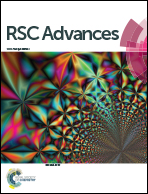Preparation of PVA hydrogel with high-transparence and investigations of its transparent mechanism†
Abstract
Polyvinyl alcohol (PVA) hydrogels with high-transparence were prepared by dissolving PVA powders into dimethyl sulfoxide (DMSO) aqueous solutions with different concentrations to obtain 16.7 wt% PVA hydrogels followed by several freeze–thaw cycles. The transparence, crystallinity, mechanical strength and compositions of the PVA hydrogels were tested and analyzed by using a spectrophotometer, a universal testing machine and infrared spectroscopy (IR), indicating that when the concentration of DMSO was 80 wt%, the transparence of the PVA hydrogel displayed a maximum value of 99.8 ± 0.2%, close to that of the natural human cornea (99.7–99.9%), which is closely related to the interaction between DMSO and H2O molecules as well as the crystallinity of the PVA hydrogel. Based on this, the interaction between DMSO and H2O molecules and the transparent mechanism were also explored. It has been found that the viscosity of the DMSO aqueous solution reaches the maximum value when its concentration is 68.5% and is prone to be affected by temperature, while the 80 wt% DMSO aqueous solution endows the PVA hydrogel with the highest transparence. Based on IR and DSC analysis, the spatial structures of the PVA hydrogels prepared with different DMSO aqueous solutions were schematised, and it was thought that the formation of a 1DMSO/2H2O network structure contributes the most to the crystallinity and the transparence of the PVA hydrogel. Such a PVA hydrogel with high transparence could have great potential to be used as the optical core of an artificial cornea.


 Please wait while we load your content...
Please wait while we load your content...